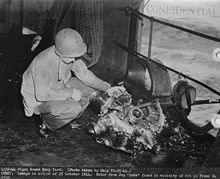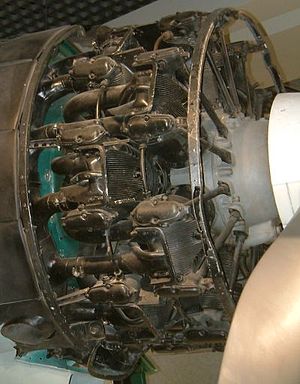- Nakajima Sakae
-
Sakae Nakajima Sakae engine on a Mitsubishi Zero Type Piston aircraft engine Manufacturer Nakajima Major applications Mitsubishi A6M
Nakajima Ki-43Number built 30,233 Developed from Gnome-Rhone 14K The Nakajima Sakae (栄 Prosperity) was a two-row, 14-cylinder air-cooled radial engine used in a number of combat aircraft of the Imperial Japanese Navy and Imperial Japanese Army before and during World War II.[1]
Contents
Design and development
The engine was designed by Nakajima Aircraft Company after acquiring a license for the French Gnome-Rhone 14K. The Imperial Japanese Army Air Force called the first of the series the Ha-25 (ハ25) and later versions were designated Ha35, Ha105 and Ha115, while the Imperial Japanese Navy Air Service designation was Nakajima NK1, with sub-types identified by Model numbers; thus Nakajima NK1 Sakae 10, 20 and 30 series.
A total of 21,166 were made by Nakajima; 9,067 were manufactured by other firms.
Variants
- Army Type 99 975 hp Air-cooled Radial
- Long Army designation for the Nakajima NK1 radial engine named Sakae.
- Nakajima Ha25
- Short Army designation for the initial production version of the Nakajima NK1 radial engine named Sakae.
- Nakajima Ha35
- Nakajima Ha35 Model 11
- Nakajima Ha35 Model 12
- Nakajima Ha35 Model 23 - 1,150 hp (858 kW)
- Nakajima Ha105
- Nakajima Ha115
- Nakajima Ha115-I
- Nakajima Ha115-II
- Nakajima NK1
- NK1C Sakae 12 - 925 hp (690 kW) , 940 hp (701 kW) , 975 hp (727 kW)
- NK1D Sakae 11 - 970 hp (723 kW) , 985 hp (735 kW)
- NK1F Sakae 21 - 1,115 hp (831 kW) , 1,130 hp (843 kW)
- NK1F Sakae 31 - 1,130 hp (843 kW) , boosted to 1,210 hp (902 kW) with water-methanol injection
Applications
- Kawasaki Ki-48
- Mitsubishi A6M
- Mitsubishi C5M
- Nakajima B5N
- Nakajima J1N
- Nakajima Ki-43
- Nakajima Ki-115
- Kawasaki Ki-56
Specifications (Sakae 21)
 USS Suwannee after the Kamikaze attack of 25 October 1944. Parts of the A6M5 Kamikaze-Zero's Nakajima Sakae 21, 14-cylinder radial engine were found in the vicinity of the hit. Cylinder heads are destroyed, connecting rods and crankshaft are visible.
USS Suwannee after the Kamikaze attack of 25 October 1944. Parts of the A6M5 Kamikaze-Zero's Nakajima Sakae 21, 14-cylinder radial engine were found in the vicinity of the hit. Cylinder heads are destroyed, connecting rods and crankshaft are visible.
Data from Jane's.[2]
General characteristics
- Type: 14-cylinder air-cooled two-row radial engine
- Bore: 130 mm (5.1 in)
- Stroke: 150 mm (5.9 in)
- Displacement: 27.8 L (1,700 in³)
- Length: 1,600 mm (63 in)
- Diameter: 1,144 mm (45.0 in)
- Dry weight: 533 kg (1,180 lb)
Components
- Valvetrain: Overhead valve
- Supercharger: Gear driven, two speed.
- Fuel system: Nakajima twin choke carburettor, automatic mixture and boost control.
- Cooling system: Air-cooled
Performance
- Power output: 761 kW (1,020 hp) at 2,600 rpm at 6,400 ft (1,950 m)
- Specific power: 30.2 kW/L (0.66 hp/in³)
- Compression ratio: 7:1
- Power-to-weight ratio: 1.43 kW/kg (0.87 hp/lb)
See also
- Comparable engines
- BMW 801
- Bristol Hercules
- Pratt & Whitney R-1830
- Wright R-2600
- Fiat A.74
- Gnome-Rhône 14N
- Mitsubishi Kinsei
- Shvetsov ASh-82
- Related lists
References
Notes
Bibliography
- Gunston, Bill. World Encyclopedia of Aero Engines. Cambridge, England. Patrick Stephens Limited, 1989. ISBN 1-85260-163-9
- Jane's Fighting Aircraft of World War II. London. Studio Editions Ltd, 1989. ISBN 0-517-67964-7
- Peattie, Mark R., Sunburst: The Rise of Japanese Naval Air Power 1909-1941, Annapolis, Maryland: Naval Institute Press, 2001, ISBN 1-55750-432-6
External links
Nakajima aircraft engines Piston engines Ha-1 Kotobuki · Ha-5 · Ha-8 Hikari · Ha-103 Mamoru · Sakae · Ha-45 Homare
Imperial Japanese Army Air Service aeroengine designations 1-50 51-100 Ha-60 • Ha-70
101-200 200- Ha-201 • Ha-211 • Ha-214 • Ha-217 • Ha-505
Imperial Japanese Navy aeroengines Aichi Atsuta
Mitsubishi Nakajima Tokyo Gasu Denki Amakaze • Kamikaze
Lists relating to aviation General Aircraft (manufacturers) · Aircraft engines (manufacturers) · Airlines (defunct) · Airports · Civil authorities · Museums · Registration prefixes · Rotorcraft (manufacturers) · TimelineMilitary Accidents/incidents Records Categories:- Radial engines
- Aircraft piston engines 1930-1939
- Nakajima aircraft engines
Wikimedia Foundation. 2010.

